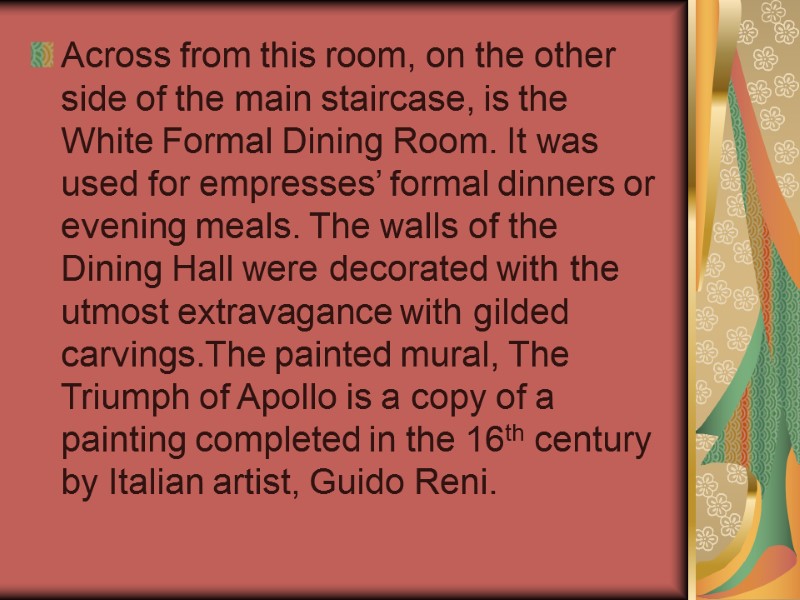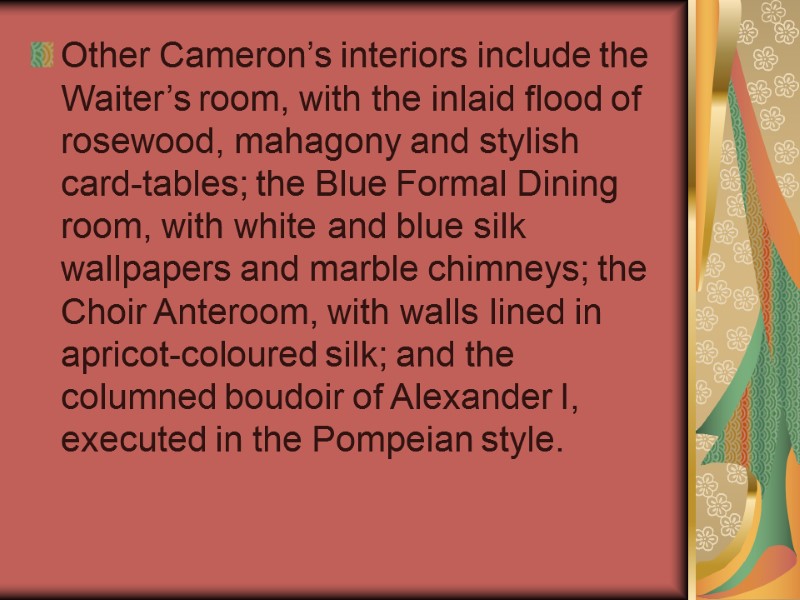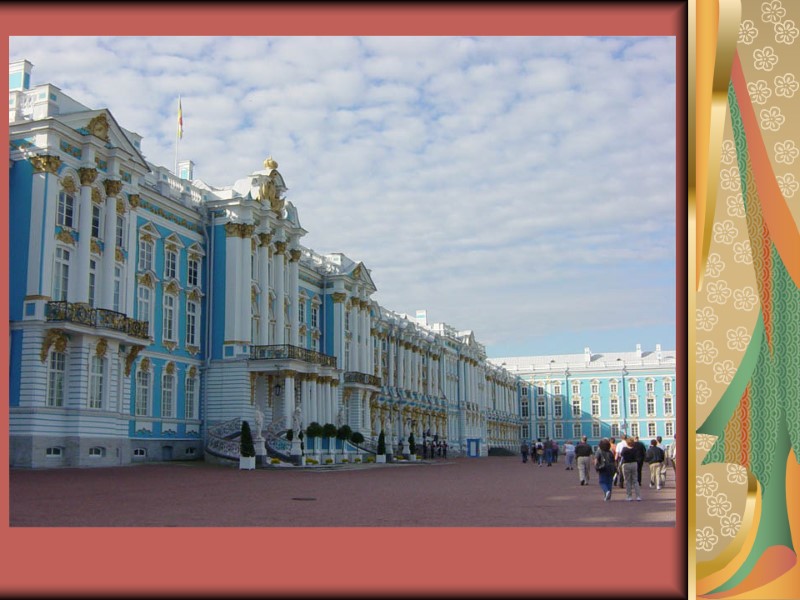THE GREAT CATHERINE PALACE GENERAL INFORMATION The Catherine





















11350-the_great_catherine_palace.ppt
- Количество слайдов: 20
 THE GREAT CATHERINE PALACE
THE GREAT CATHERINE PALACE
 GENERAL INFORMATION The Catherine Palace is the Rococo summer residence of the Russian tsars, located in the town of Tsarskoye Selo, 25 km south-east of St.Petersburg, Russia
GENERAL INFORMATION The Catherine Palace is the Rococo summer residence of the Russian tsars, located in the town of Tsarskoye Selo, 25 km south-east of St.Petersburg, Russia
 OUTER BUILDINGS
OUTER BUILDINGS

 HISTORY OF CONSTRUCTION Although the palace is populary associated with Catherine the Great, she actually regarded its “whipped-cream architecture” as old-fashioned. When she ascended the throne, a number of statues in the park were being covered with gold, in accordance with the last wish of empress Elizabeth, yet the new monarch had all the works suspended upon being informed about the expense.
HISTORY OF CONSTRUCTION Although the palace is populary associated with Catherine the Great, she actually regarded its “whipped-cream architecture” as old-fashioned. When she ascended the throne, a number of statues in the park were being covered with gold, in accordance with the last wish of empress Elizabeth, yet the new monarch had all the works suspended upon being informed about the expense.
 In order to gratify her passion for antique art, Catherine employed the Scottish architect Charles Cameron who not only refurbished the interior, but also constructed the personal apartments of the empress, a rather modest Greek Revival structure known as the Agate rooms and situated to the left of the palace. According to Catherine wishes, many remarkable structures for her amusement in the park.
In order to gratify her passion for antique art, Catherine employed the Scottish architect Charles Cameron who not only refurbished the interior, but also constructed the personal apartments of the empress, a rather modest Greek Revival structure known as the Agate rooms and situated to the left of the palace. According to Catherine wishes, many remarkable structures for her amusement in the park.
 Upon Catherine’s death in 1796, the palace was abandoned in favour of the Pavlovsk Palace. Subsequent monarchs preferred to reside in the nearby Alexander Palace. But in 1817, Alexander I engaged Vasily Stasov to refurbish some interiors of the grandmother’s palace in the Empire style. Twenty years later, the magnificent Stasov staircase was constructed to replace the old circular one leading to the palace chapel. Unfortunately, the most Stasov interiors haven’t been restored after the World War II. When the German military forces retreated after the seige of Leningrad, they had the residence intentionally destroyed, leaving the hollow shell of the palace behind.
Upon Catherine’s death in 1796, the palace was abandoned in favour of the Pavlovsk Palace. Subsequent monarchs preferred to reside in the nearby Alexander Palace. But in 1817, Alexander I engaged Vasily Stasov to refurbish some interiors of the grandmother’s palace in the Empire style. Twenty years later, the magnificent Stasov staircase was constructed to replace the old circular one leading to the palace chapel. Unfortunately, the most Stasov interiors haven’t been restored after the World War II. When the German military forces retreated after the seige of Leningrad, they had the residence intentionally destroyed, leaving the hollow shell of the palace behind.
 THE GRILLE
THE GRILLE
 Although Stasov’s and Cameron’s Neoclassical interiors are superb manifistations of the late 18th-century and early 19th-century taste, the palace is best known for Rastrelli’s grand suit of formal rooms known as the Golden Enfilade. It starts at the spacious airy ballroom, the Grand Hall, and comprises numerous destinctively decorated smaller rooms, including the reproduced Amber room.
Although Stasov’s and Cameron’s Neoclassical interiors are superb manifistations of the late 18th-century and early 19th-century taste, the palace is best known for Rastrelli’s grand suit of formal rooms known as the Golden Enfilade. It starts at the spacious airy ballroom, the Grand Hall, and comprises numerous destinctively decorated smaller rooms, including the reproduced Amber room.




 THE GREAT HALL The Great Hall, or the light gallery as it was called in the 18th century, is a formal apartment in the Russian baroque style designed by Bartolomeo Rastrelli between 1752 and 1756. It was intended for such important receptions as balls, formal dinners, masquerades. The hall was painted in two colours and covers an area of 1000 square meters. Occupying the entire width of the palace the windows look out to the different sides of the palace.
THE GREAT HALL The Great Hall, or the light gallery as it was called in the 18th century, is a formal apartment in the Russian baroque style designed by Bartolomeo Rastrelli between 1752 and 1756. It was intended for such important receptions as balls, formal dinners, masquerades. The hall was painted in two colours and covers an area of 1000 square meters. Occupying the entire width of the palace the windows look out to the different sides of the palace.
 SOME MORE ROOMS Beyond the Great Hall is the dining room for the courtiers in attendance. The room was designed by Rastrelli in the mid-18th century. It’s lit by 4 windows which look out in the formal courtyard. The architect placed false windows and mirrored glass on the opposite wall, making the hall more spacious and bright. Decorated in the typical baroque interior style, the hall is filled with gilded wall-carvings, and ornamental patterns of flowers.
SOME MORE ROOMS Beyond the Great Hall is the dining room for the courtiers in attendance. The room was designed by Rastrelli in the mid-18th century. It’s lit by 4 windows which look out in the formal courtyard. The architect placed false windows and mirrored glass on the opposite wall, making the hall more spacious and bright. Decorated in the typical baroque interior style, the hall is filled with gilded wall-carvings, and ornamental patterns of flowers.
 Across from this room, on the other side of the main staircase, is the White Formal Dining Room. It was used for empresses’ formal dinners or evening meals. The walls of the Dining Hall were decorated with the utmost extravagance with gilded carvings.The painted mural, The Triumph of Apollo is a copy of a painting completed in the 16th century by Italian artist, Guido Reni.
Across from this room, on the other side of the main staircase, is the White Formal Dining Room. It was used for empresses’ formal dinners or evening meals. The walls of the Dining Hall were decorated with the utmost extravagance with gilded carvings.The painted mural, The Triumph of Apollo is a copy of a painting completed in the 16th century by Italian artist, Guido Reni.
 The Portrait Hall is a formal apartment that covers 100 square meters of space. The room’s walls boast large formal portraits of Catherine I, Elizabeth Petrovna and Catherine II. The inlaid floors of the hall contain pricious woods. The Green Dining Room, which replaced Rastrelli’s hanging gardens in 1773, is the first of the rooms in the northern wing of the palace, designed by Cameron for the future emperor Paul. During the fire of 1820 the room was seriously damaged, later restored under Stasov’s direction.
The Portrait Hall is a formal apartment that covers 100 square meters of space. The room’s walls boast large formal portraits of Catherine I, Elizabeth Petrovna and Catherine II. The inlaid floors of the hall contain pricious woods. The Green Dining Room, which replaced Rastrelli’s hanging gardens in 1773, is the first of the rooms in the northern wing of the palace, designed by Cameron for the future emperor Paul. During the fire of 1820 the room was seriously damaged, later restored under Stasov’s direction.
 Other Cameron’s interiors include the Waiter’s room, with the inlaid flood of rosewood, mahagony and stylish card-tables; the Blue Formal Dining room, with white and blue silk wallpapers and marble chimneys; the Choir Anteroom, with walls lined in apricot-coloured silk; and the columned boudoir of Alexander I, executed in the Pompeian style.
Other Cameron’s interiors include the Waiter’s room, with the inlaid flood of rosewood, mahagony and stylish card-tables; the Blue Formal Dining room, with white and blue silk wallpapers and marble chimneys; the Choir Anteroom, with walls lined in apricot-coloured silk; and the columned boudoir of Alexander I, executed in the Pompeian style.

 WELCOME!
WELCOME!

